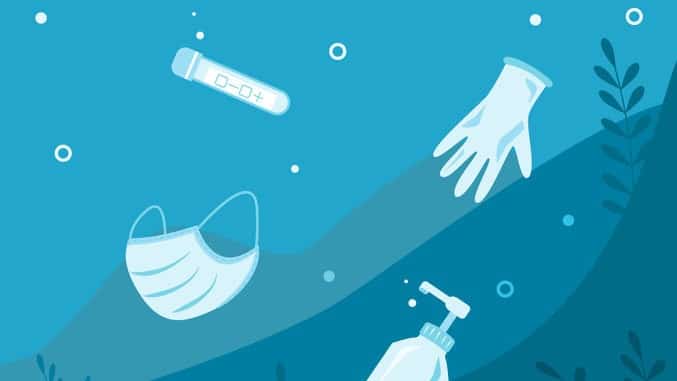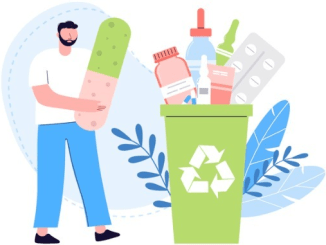
Although measures to control COVID-19 have been associated with some positive environmental effects – including decreases in global emissions of carbon dioxide – the pandemic has exacerbated plastic pollution through high use of personal protective equipment
CREDIT: This is an edited version of an article that originally appeared on The BMJ
In England alone, 2.3bn items of single use personal protective equipment (PPE) were distributed to health and social care services between February and July 2020, the same amount as was distributed throughout the whole of 2019. Globally, 129bn face masks and 65bn gloves are estimated to have been used every month during the COVID-19 pandemic. The disposable face mask market is estimated to have increased from $800m in 2019 to $166bn in 2020.
If usual patterns of disposal continue, around 75% of plastic PPE waste related to COVID-19 will end up in landfills, or ocean environments. Evidence of improper disposal of PPE is emerging, with plastic masks and gloves found on beaches, ocean beds and urban environments globally.
Surgical face masks, gloves and gowns are commonly manufactured from plastics that break down slowly, such as polypropylene, polyurethane, polyacrylonitrile, polyethylene and polyethylene terephthalate. A surgical mask made from these materials could take 450 years to fully decompose.
These plastics are dispersed globally by wind and ocean currents and may persist as microplastics (fragments <5 mm). Plastic pollution has substantial adverse environmental effects, including injury to wildlife (through ingestion) and toxicity to ecosystems (through release of additives or adsorbed contaminants and pathogens). Growing evidence suggests that microplastics are potentially harmful to aquatic organisms, and enter human food chains where they may adversely affect health.
Better management
PPE waste overwhelmed waste management systems during the first wave of the pandemic. Capacity for local incineration, the mainstay of clinical waste disposal, was exceeded, increasing use of landfill and, potentially, contributing to improper PPE disposal.
In Wuhan, China, clinical waste increased fourfold during its COVID-19 outbreak, and mobile incinerators were deployed to meet demand. In the UK, municipal waste incinerators were given permission to process medical waste. Although incinerators have adverse environmental consequences, including greenhouse gas emissions and the release of hazardous compounds, such as dioxins, their overall harm is less than landfill if appropriate pollution controls and technologies are used.
Capacity strains on waste management systems have highlighted the need to consider surge capacity and the environmental impact of waste in disaster management plans.
Another challenge to waste management is that contaminated PPE could transmit disease. This potential risk, combined with the complex composition of some types of single use PPE, make waste recycling challenging. Surgical masks, for example, contain multiple different plastic polymers and other materials. Waste from masks must be separated into component parts and sterilised before processing. Research into better methods of recycling PPE is ongoing, exploring methods such as feedstock recycling—breaking polymers into smaller molecules that can be used to create new products—or conversion into liquid fuels.
Single use PPE is vital to prevent infection, and control disease, in healthcare settings, alongside other measures such as physical distancing, hand hygiene and source isolation. Although vaccines are expected to reduce the spread of COVID-19, roll-out across the global population faces multiple logistical challenges, and is likely to be slow. So, the increased use of disposable PPE is likely to persist.
Strategies to reduce unnecessary exposure to potential pathogens – such as physical distancing and source isolation – should be the first line of defence, before PPE is needed, to reduce infection risk in healthcare settings and among the public. Rational and evidence-based use of PPE will help reduce risk of shortages and control unnecessary waste.
Aside from PPE-related waste, the pandemic has increased consumption of single-use plastics more broadly. This has been driven by what is likely to be a permanent shift towards industries that require more single-use plastics, for example, e-commerce and takeaway food providers, and a public perception that single use plastics are more hygienic. Governments in the UK, Portugal, and some US states, have reversed or delayed environmental policies restricting single-use plastics during the pandemic.
Although justified by the public health crisis, these policy changes have slowed hard won progress towards reducing the global impact of plastic pollution. It is now even more important that governments and non-governmental organisations alike design and implement policies to reduce use of plastics, educate the public, develop alternative materials and promote a circular plastic economy where plastic products are recycled, refined, or reused at the end of their lifecycle. Together, these changes would help reduce the grave environmental threat caused by plastic pollution.
The COVID-19 pandemic has greatly exacerbated the global environmental threat of plastic pollution. Although management of the public health crisis is the priority, governments and healthcare systems must, simultaneously, implement strategies to mitigate the environmental consequences of the pandemic.


Be the first to comment